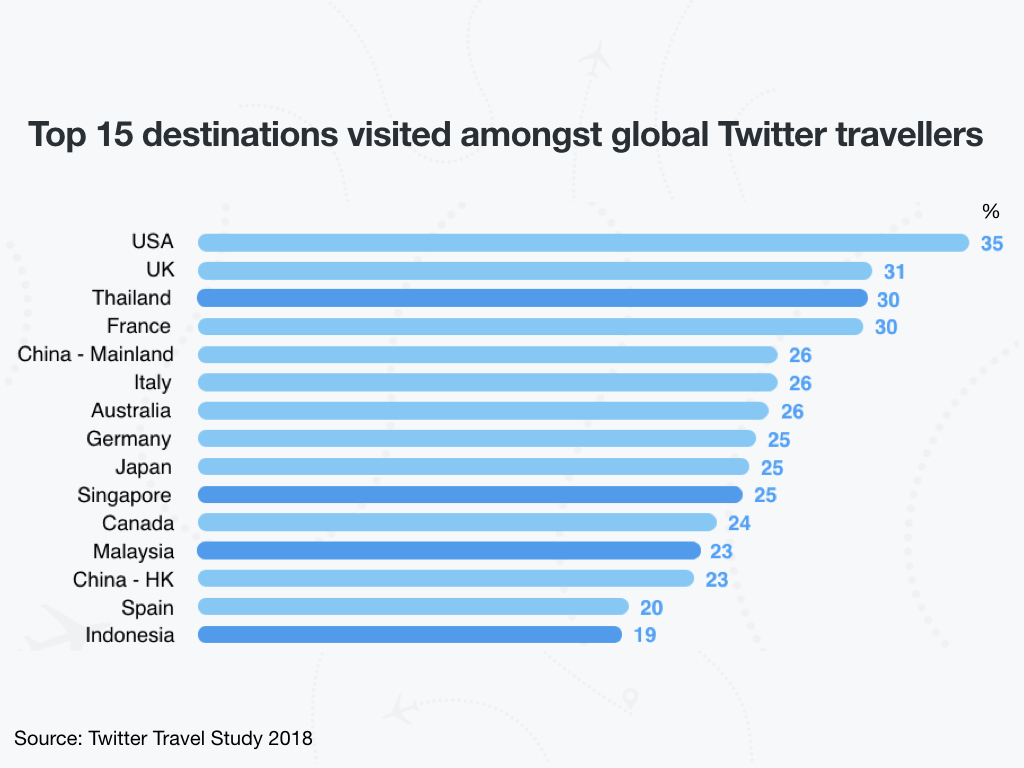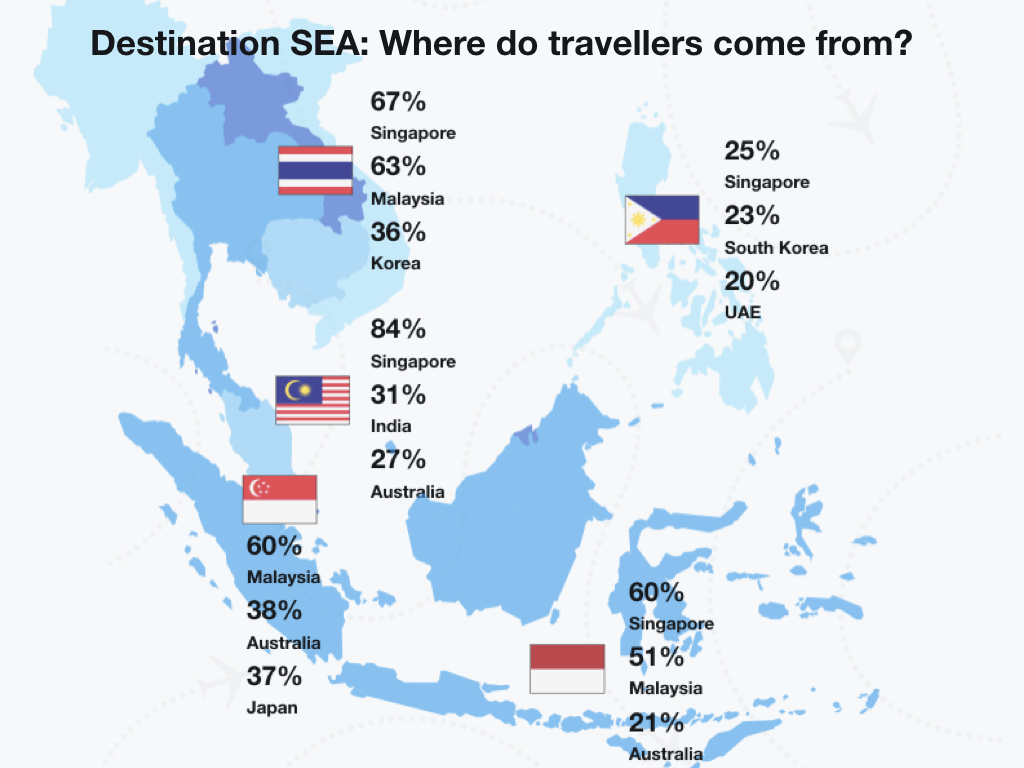Research
Eight essential travel insights for APAC marketers

We unveil travel trends and takeaways all travel marketers in Asia Pacific should know. Download the full report to discover how these insights can help connect you to your most valuable and receptive audience.
People turn to Twitter to discover new things, make recommendations, and share their experiences with the world. When it comes to travel, this rings especially true, with travellers flocking to the platform to decide on their next vacation destination or to do research on their travel itinerary.
1. Global travel trends from achievement travel to JOMO (Joy Of Missing Out):
Today, more travellers are choosing to push their boundaries on holiday. Rather than simply experiencing the vibe and culture of a country, city, or destination, achievement travel is all about “overcoming challenges, feeling a sense of accomplishment, and learning a little more about yourself”1 .It’s on the rise worldwide as travellers look to scale new heights and explore new depths for rewarding, potentially life-changing challenges to overcome.
Achievement travel most often appeals to individuals or couples. But multigenerational travel is also popular, with seven in 10 families globally taking two family holidays a year. This is especially evident in Asian countries where family ties are strong. According to Agoda, 66% of Thai travellers and 54% of Indonesians have taken a holiday with grandparents2. That’s probably not surprising. Grandparents get to indulge grandchildren and parents who want to let loose on holiday have willing babysitters3.
Making sure that all the generations experience the world’s most amazing sights while they still can is driving the trend for what’s called “last chance travel”. Destinations such as Australia’s Great Barrier Reef, Israel’s Dead Sea, and the Northwest Territories are all experiencing a rise in visitors as travellers flock to see these natural wonders as the effects of climate change become more pronounced.
On the other hand, for an increasing number of travellers, the Joy Of Missing Out (JOMO) has replaced FOMO (Fear Of Missing Out). In fact, Wellness travel is predicted to increase by 43% to $808 billion from 2015 to 20204.
2. Twitter users talk about travel – 354 million Tweets say it all.
People love to talk travel on Twitter, and this is especially prominent during the holidays, where feeds are flooded with vacation “wefies” and Christmas spreads. There were an impressive 354 million travel-related Tweets in 20185. Top Tweeting countries were the US, UK, India, Indonesia, and Canada. Expectedly, travel-related Tweets peaked just before Christmas at 9 million.
The first week of July was the other peak period, with 8.6 million Tweets. Summer’s here, school’s out, the beach beckons, and users are Tweeting for last minute break recommendations or fishing for inside information on the holiday destination they’ve chosen.
3. Twitter travellers are more likely to venture into the unknown.
When it comes to travelling for leisure, 21% of Twitter travellers worldwide have taken a medium or long-haul holiday abroad in the past six months compared to 17% of non-Twitter travellers6.
Asia Pacific Twitter travellers are bold – 27% agree that they’re open to exploring new destinations while only 15% of non-Twitter travellers are as fearless7.
According to Twitter Travel Study 2018, US travellers tend to go for luxury, placing more emphasis on comfort than their UK counterparts8. Travellers from the UK love wildlife, local attractions, and beaches9. Conversely, French, German, and Spanish travellers appreciate value for money and cultural heritage more than their fellow travellers10.
4. Twitter travellers love Southeast Asia – Thailand and Singapore amongst top destinations visited.
According to the study, Twitter travellers love Southeast Asia. They’re attracted by mouthwateringly local cuisine, rich cultures, and the natural environment of the region. Affordability and a good reputation for safety also add to the appeal.

5. Twitter travellers from APAC travel abroad for leisure most frequently and South Korea leads the way.
Among Twitter travellers, those from Asia Pacific are most likely to hop on a plane and take off for leisure. In fact, South Korea has the most active international travellers when it comes to leisure, with 13.9% having taken more than five international trips in the past year. Singapore (12.7%) and Australia (11.8%) are not far behind11.
6. Tracing Twitter travellers to SEA: Where do they come from and what do they come for?
The Twitter Travel Study reveals that the top five destinations in SEA are Thailand, Singapore, Indonesia, the Philippines, and Malaysia. So why do they come?
Visitors to Thailand and Singapore are attracted by the cuisine, rich heritage, and natural environment of these countries. Indonesia, too, has a colourful heritage and fascinating history but is also exceptionally good value. Malaysia is a magnet for travellers who love to shop, visit attractions, and soak up its vibrant city lifestyle. Travellers heading to the Philippines delight in its breathtaking beauty, glorious nature, and an incredibly varied cuisine12.

7. Western travellers present a bright opportunity for SEA destinations.
While current feeder markets for destinations in SEA are neighbouring countries within Asia Pacific, the increase in intention to visit SEA destinations are highest amongst travellers in the US, UK, and Europe13.
8. Reach your most valuable and receptive audience on Twitter:
If yours is a travel brand, Twitter travellers represent an extremely attractive audience. An impressive 26% are always looking out for holiday ideas, compared to 16% of non-Twitter travellers14. Social shapes their destination choices. Worldwide, 22% of travellers strongly agreed that they’re more likely to consider destinations they discover advertised or on social media. The figure was only 9% for non-Twitter travellers.
What does this mean for marketers?
With this information, marketers can speak directly and more effectively to a Twitter audience that’s already engaged and receptive to travel messaging. And by understanding where they intend to head to and why, you’ll be able to tailor your message directly to your audience. By digging into the insights from Twitter’s audience, you’ll also have a better sense of who you should target and when you want to message them during travel seasons. With these insights, you’ll be better prepared to position yourself in the crowded marketplace.
Download the SEA Travel Report here for the full insights.
Methodology
Twitter surveyed 7,511 Twitter users and non-users across 13 markets globally, from Aug-Sept 2018. All survey respondents met the criteria of having taken at least two international leisure trips in the past 12 months as well as intending to take at least one international leisure trip in the next 12 months.
Footnotes:
[1] https://nypost.com/2014/06/06/why-people-risk-their-lives-mountain-climbing/
[2] https://www.agoda.com/press/family-travel-trends-2018
[3] https://www.thetravelcurrent.com/content/kids-rule-and-other-multigenerational-travel-trends
[4] https://www.wexinc.com/insights/blog/wex-travel/wellness-travel/
[5] Crimson Hexagon, Jan-Dec 2018
[6] GlobalWebIndex
[7-14] Twitter Travel Study 2018